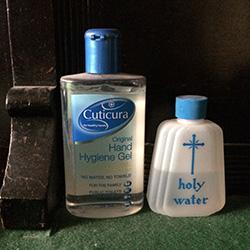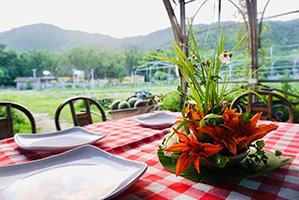Crises beg(et) creativity. A readiness to navigate change and constraint undergirds the descriptive enterprise of anthropology — beginning, perhaps, with Malinowski’s ethnographic research on the Trobriand Islands during World War I, and characteristic of the discipline even now. Having conducted fieldwork during the COVID-19 pandemic, we offer some brief reflections on the capacity of the ethnographic method not only to journey through radical uncertainty, but also to gain clarity amid turmoil.
Dark Windows, Surfaced Values, Carolyn Dreyer
I conducted fieldwork amongst Anglo-Catholics in Oxford, England. About 10 months into my research, England entered a strict lockdown in response to the pandemic. In that period of chaos and uncertainty, features of Anglo-Catholicism that I had taken for granted, left unexamined as mundane substrate, rose to the surface. It is a truism, but here strikingly relevant, that people’s values become most clear when they are put to the test.
Once during the lockdown, I caught myself staring forlornly into the empty window of a bakery which had closed, wishing for a bit of comfort and normalcy. Similarly distraught, one of my interlocutors began making regular trips to peer in the side window of a parish church; locked, dark, silent. On the altar she could see the Blessed Sacrament, the bread that had been consecrated with divine presence at the last mass celebrated in the church before it closed. My interlocutor found comfort in those trips to visit Christ.
I deliberately juxtapose our reactions to the lockdown in order to convey something of the ethnographic revelation that impinged itself upon me during the pandemic. My interlocutors described sacramental absence as a weight upon their souls, a spiritual danger. They critiqued their bishops for locking churches, flouted restrictions to deliver the Sacrament to isolated parishioners (safely, I assure you), trespassed in church gardens.
Perhaps I would have realized the importance of sacramentality to Anglo-Catholics anyway. But I suspect a certain grounding weight to this value revealed itself to me only during the pandemic, because there was nothing else left on which my interlocutors could ground themselves. Just as the pandemic changed how I understood my field site, it also changed how we understood the ethnographic project and our position within it.
Image: Two preventative health measures, physical and spiritual, offered in an Anglo-Catholic church.
‘Self as Method’, Others as Mirror, Liang-Liang Zhang
I had just returned from the field when COVID-19 struck. As the university closed in March 2020, I relocated back home to a southern Chinese city. The ensuing year of virtual and sedentary existence, unexpectedly, sparked a long reflection on the affordances of the ethnographic method.
Many months into the remote writing-up life, adrift and dispirited, I chanced upon Self as Method (1). In this, anthropologist Xiang Biao urged Chinese youth to think through their micro-level experiences in order to grasp the macro-level complexities confronting their society. The simple message drove home the power of the ethnographic method to reveal insight through reflective participation in one’s situated realities, however ordinary or unfavourable these may be.
Feeling encouraged, I turned a critical eye to my own pandemic experience.
While finishing a doctoral degree remotely across an 8-hour time difference was particular to me, with the ‘zero covid’ policy adopted by the Chinese government and its strict implementation, over 800 million Chinese urban dwellers found themselves in an analogous situation — being ‘grounded’ for an indeterminate period. In a sense, our lived experiences were thrust into unprecedented synchronicity. Thinking through this shared ‘grounded-ness’ while attending to popular discourse enabled two realisations.
Firstly, urban Chinese were compelled to ‘reconceive’ the field for everyday life, just as I was compelled to ‘reconceive’ the field for ethnographic research; these processes endowed the ‘nearby’ with new significance.
Secondly, prolonged movement restrictions surprisingly disturbed the entrenched urban-rural divide in the PRC and the superiority imputed to urban life. As city dwellers (myself included) yearned for escaping into the countryside nearby, the once ‘underdeveloped’ rural China became inscribed with the new values of biological security, ecological richness, and socio-psychological comfort. These shifting public opinions were accompanied by an incipient trend of urban-to-rural migration, which has yet to be ethnographically understood.
In the final year of writing-up, I started examining the ‘nearby’ as an ethnographic space and attending to ‘rural China’ as an analytical project. These reflections led to some preliminary fieldwork at a nearby village, where dozens of urban-to-rural migrants were engaging village residents in the formation of an ecological living community, wishing to ‘reaffirm the value and the goodness of rural China’.
Living through the pandemic ethnographically enabled us to capture new findings, develop our methodological and theoretical approaches, and contingently embark upon exploratory research. Using the ‘self as method’ and others as mirror, anthropologists can glean insights into their situated localities and indeed probe the human condition, even in times of crises.
[1] Originally published in Chinese as baziji zuowei fangfa (2020).
Image: An impromptu flower arrangement composed of wildflowers, bamboo, and banana leaves at an all-village 'Earth Banquet'.
When Gotham Became Ghostly, Sally Raudon
In June 2019, I started fieldwork in New York City, looking at how citizenship survives death through the lens of what happens to New Yorkers who can’t afford a funeral. I was especially interested in the city’s potter’s field, a massed burial ground on Hart Island.
By February 2020 people were discussing Covid seriously. My roommate was told to prepare to work from home for two to three weeks. We installed shelving in the living room for food – New York apartment kitchens are tiny with limited storage, as the city runs on takeout.
In early March, public institutions closed. International travel bans rapidly expanded. On the streets, wealthy people talked urgently about evacuating to their summer homes, if the Wi-Fi was up to it. At the homeless dinner service where I volunteered, client numbers halved in a week as the homeless also left town. City workers closed drinking fountains and removed hoops from basketball courts, lest they became infection vectors. I watched a fistfight in a local bodega over bottled water, and stood in a 500-person queue for groceries. Panic was everywhere.
As a State of Emergency was declared, the streets become eerily silent. But ambulance sirens screamed constantly.
I was a foreigner with limited health insurance and serious asthma. I returned to the UK in March, the day before the border closed.
I took my fieldwork online, just as I would have had to do in New York. As it became Covid’s early global epicentre, I watched Hart Island’s massed graves became international news: a key symbol of the scale of the crisis, and how authorities struggled to deal with the dead respectfully.
Interviews that I’d had lined up fell through, as funeral directors, politicians and officials were consumed with the emergency, which gave me space to pursue less obvious fieldwork connections. Further, now that everyone was always at home online I suddenly gleamed small, privileged insights into people’s domesticity.
By June New York looked safer and I began planning to return, despite the US-UK border remaining closed, and the US busily cancelling some research visa categories. I twice booked tickets at extortionate prices on flights that turned out not to exist. Finally, I travelled through a third country, which diverted me through a fourth.
Back in locked-down NYC, my neighbourhood had the dystopian stillness of Christmas Day, every day, and joylessly. Almost 100 local businesses had gone under. I left my apartment once a week for Hebrew Free Burial, which provides funerals for impoverished New York Jews. Given circumstances, most of their year’s filing was sitting around the office in neat piles and I set to work processing it. April’s stack of death certificates and burial authorisations was more than the rest of the year combined.
Fieldwork during Covid required strong nerves and ready credit. The pandemic made it impossible for me to continue the kind of fieldwork we value: face-to-face and alongside local people. Yet, Covid increased my project’s urgency, and made visible some taken-for-granted infrastructures of deathcare and citizenship that are usually hard to see.
Image: Hart Island, New York City, 9 April 2021. Credit: Lucas Jackson, Reuters.
Double your impact with the Harding Challenge
You may have already heard about the Harding Challenge from your College, but did you know a gift to your department could also qualify?
If you are a new donor to the Collegiate University, or have not given since July 2019, your gift to support students in the Department of Social Anthropology will be eligible for the Harding Challenge. As such, your gift will unlock, pound for pound, a contribution to a special fund for undergraduate financial support, benefitting both Social Anthropology and undergraduates in greatest need across Cambridge.
This time-limited challenge is the first time Collegiate Cambridge has come together in a fundraising effort to extend the impact of a donor’s gift, which enables us to do more for undergraduates than ever before. Every pound really does make a difference, so please do consider taking advantage of this opportunity to amplify the impact of your donation
Donations to support students in their fieldwork, can be made using this link.



